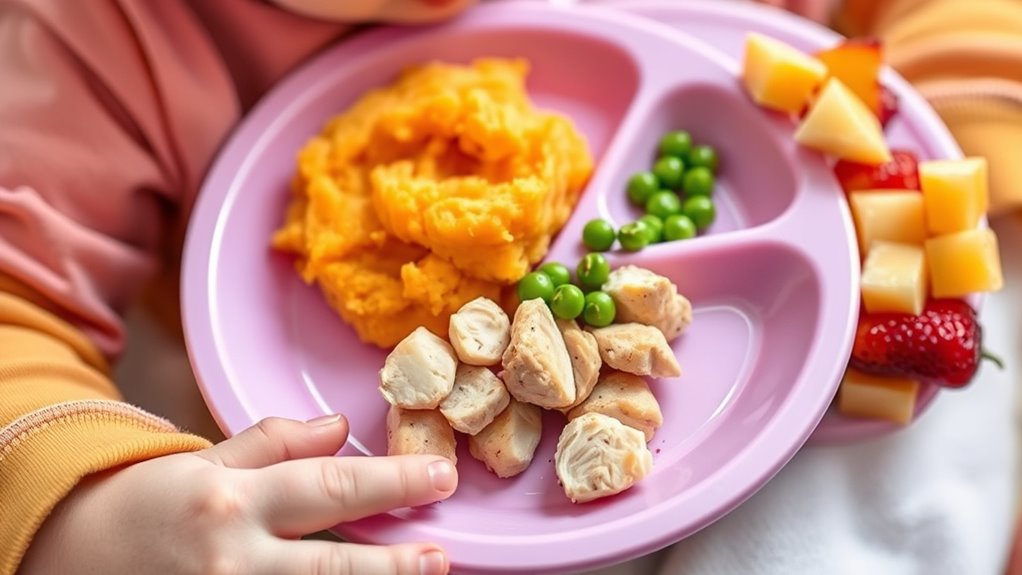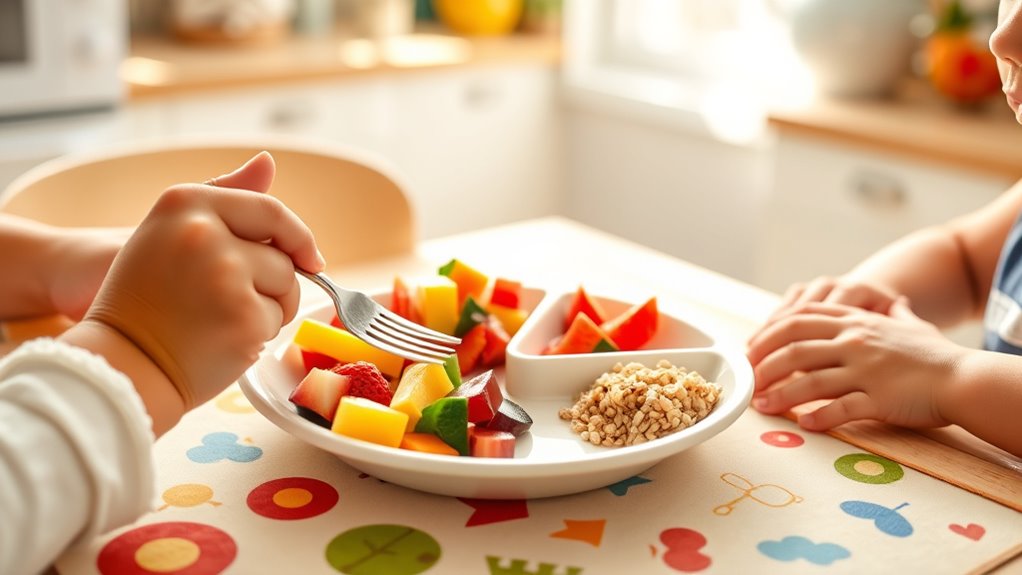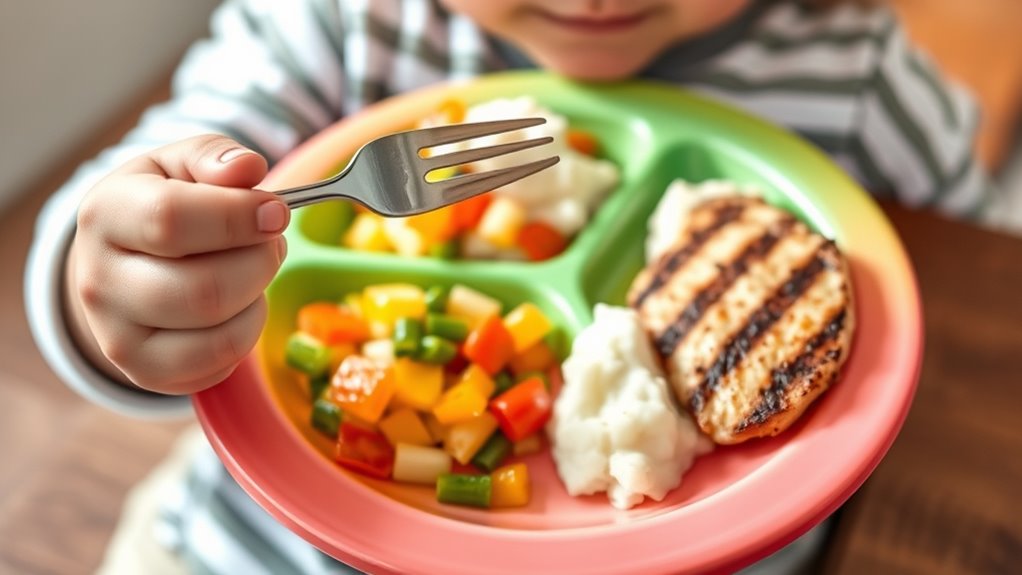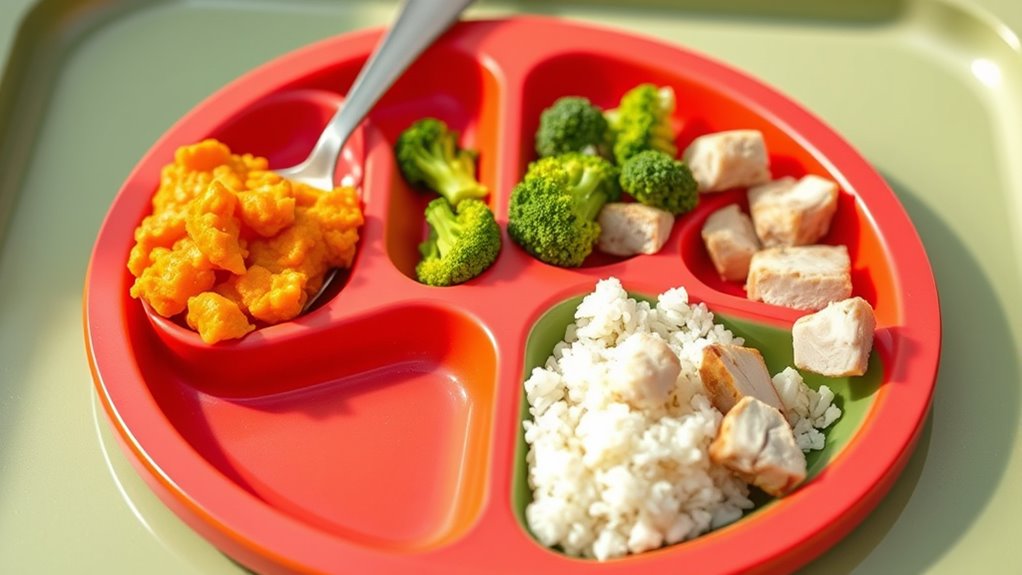Knowing your toddler’s portion sizes helps guarantee they get the right nutrients without overeating. Serve age-appropriate amounts based on their hunger cues, like about 1 tablespoon per year for fruits and vegetables or a small handful of protein. Watch for signs they’re full or still hungry to adjust portions accordingly. Establish routines, limit snacks, and use visual cues to prevent overfeeding. Keep info handy—there’s more to learn about managing toddler portions effectively.
Key Takeaways
- Recognize hunger and fullness cues, such as turning away or reaching for more, to serve appropriate portion sizes.
- Use visual cues like a child’s palm or small handfuls to determine age-appropriate servings.
- Follow dietary guidelines: about 1-1.5 tablespoons of fruits/vegetables per year, and suitable amounts of proteins, grains, and dairy.
- Adjust portion sizes gradually based on the child’s growth, activity level, and hunger signals.
- Avoid common mistakes like over-serving, rushing meals, or pressuring children to finish, and trust their cues for healthy habits.
Understanding Toddler Nutritional Needs

Understanding your toddler’s nutritional needs is essential for supporting their growth and development. Proper meal timing helps establish routines and guarantees your child gets energy throughout the day. Typically, toddlers eat three main meals and two to three snacks daily, which keeps their blood sugar stable. Snack frequency is important because it prevents hunger without overfeeding, and it encourages healthy eating habits early on. Pay attention to your child’s hunger cues, and avoid forcing them to finish large portions. Small, frequent meals help meet their high energy demands and nutritional needs without overwhelming their tiny stomachs. Creating a balanced diet that includes a variety of foods ensures your toddler receives all necessary nutrients. Additionally, understanding nutritional guidelines can help you make informed choices for your child’s meals. Being aware of growth patterns can also assist in tailoring their diet to support healthy development. By maintaining consistent meal times and snack schedules, you support your toddler’s overall health and help them develop a positive relationship with food.
Typical Serving Sizes for Different Food Groups

Understanding the typical serving sizes for different food groups helps you give your toddler the right amount to eat. You’ll want to know how much fruit and vegetables, protein, grains, and dairy are appropriate for their age. Getting these portions right supports their growth and keeps mealtime balanced. Incorporating age-appropriate toys into mealtime routines can also encourage healthy eating habits and positive social interactions. Being aware of nutritional guidelines can further help ensure your child’s diet is well-rounded and supports their development. Recognizing how creative practice can foster problem-solving skills may also inspire you to find innovative ways to introduce healthy foods to your toddler.
Fruit and Vegetable Servings
When it comes to toddler nutrition, knowing the appropriate portion sizes for fruits and vegetables helps guarantee they get the right amount of nutrients without overeating. Aim for about one to one and a half tablespoons of fruit or vegetables per year of age, like a small handful or slices. To promote healthy habits, focus on mealtime etiquette, encouraging your toddler to take small bites and chew slowly. Food presentation also plays a role—colorful, neatly arranged servings can make these foods more appealing. Keep portions manageable to avoid overwhelming your child. Remember, offering a variety of fruits and vegetables in appealing ways helps build a positive attitude toward healthy eating and ensures they’re getting essential vitamins and minerals. Proper portion sizes are crucial for establishing healthy eating patterns early on. Developing a mindset of balanced eating can set your child up for lifelong healthy habits.
Protein Portion Guidelines
Just like offering appropriate portions of fruits and vegetables helps guarantee your toddler gets essential nutrients, providing the right amount of protein supports their growth and development. For toddlers, meat portioning should be about 1 ounce per serving, roughly the size of their palm or a small matchbox. Focus on diverse protein sources like lean meats, poultry, fish, beans, and dairy. These options supply crucial amino acids necessary for muscle growth and brain development. Remember, portion sizes don’t need to be large; smaller, frequent servings work best for toddlers’ appetites. Always check for signs of fullness and avoid forcing them to eat more. Balancing protein with other food groups ensures your child gets a nutritious, well-rounded diet that promotes healthy growth. Incorporating proper portion sizes can also prevent overfeeding and help establish healthy eating habits early on. Being mindful of nutritional balance supports their overall development and prevents future health issues. Additionally, understanding portion control strategies can make meal times more manageable and enjoyable for both parents and children.
Grain and Dairy Sizes
Offering the right portion sizes of grains and dairy helps guarantee your toddler gets essential energy and nutrients for growth. For grains, aim for about 3 ounces daily, including various grain types like whole wheat, oats, and rice. Dairy portions should be around 2 cups, which can include milk, yogurt, or cheese. If your child has dairy allergies or intolerances, consider dairy alternatives like almond, soy, or oat milk, ensuring they’re calcium-fortified. Use the table below to guide portion sizes:
| Food Group | Typical Serving Size | Examples |
|---|---|---|
| Grains | 1 ounce | Whole wheat bread, oats |
| Dairy | 1 cup | Milk, yogurt, cheese |
| Grain variety | Mix of types | Brown rice, quinoa, barley |
Adjust based on your toddler’s appetite and dietary needs. Being aware of portion control can help maintain a balanced diet as your child grows. Regularly monitoring serving sizes supports nutritional adequacy and promotes healthy development.
Signs That Your Toddler Is Full or Still Hungry

Pay attention to your toddler’s hunger cues, like turning away or pushing food aside, to know when they’re full. Keep an eye on how much they’re eating to prevent overfeeding or underfeeding. Also, watch for behavior changes, such as fussiness or distraction, which can signal whether they’re still hungry or already satisfied. Recognizing these cues can help nurture healthy eating habits and prevent issues related to emotional manipulation from developing around mealtime. Understanding self-sufficiency principles, such as providing appropriate portion sizes, supports a balanced approach to feeding. Being aware of feeding cues helps you respond appropriately and fosters independence in your toddler’s eating habits.
Recognizing Hunger Cues
Understanding your toddler’s hunger cues is essential for feeding them appropriately. Pay attention to signs like turning away from food, closing their mouth, or pushing the spoon away—these indicate fullness. Conversely, if your toddler reaches for more or stays enthusiastic during a meal, they’re still hungry. Recognizing these cues helps you establish proper meal timing and adjust snack frequency, preventing overeating or underfeeding. Watch for subtle behaviors like fussiness or distractedness, which can also signal hunger or fullness. Remember, toddlers might not communicate their needs with words, so observing their actions is key. By tuning into these signs, you can offer portions that match their true hunger levels, fostering healthier eating habits and making mealtime more positive.
Monitoring Portion Intake
Monitoring your toddler’s portion intake involves paying close attention to their behavioral cues during and after a meal. Watch for signs they’re full, such as turning away, pushing food aside, or becoming distracted. Conversely, if your child seems enthusiastic for more or reaches repeatedly for food, they may still be hungry. To manage this effectively, consider these key points:
- Maintain consistent meal timing to help your toddler recognize when to eat and feel satisfied.
- Limit snack frequency to prevent overloading small stomachs, which can mask true hunger cues.
- Observe their reactions during meals; a lack of interest or early signs of fullness indicate they’ve had enough.
- Using appropriate portion sizes can help prevent overfeeding and ensure your child gets the right amount of nutrition. Additionally, understanding eating cues can assist caregivers in responding appropriately to your child’s needs. Recognizing hunger signals is also vital to avoid unnecessary fussiness and ensure your toddler’s nutritional needs are met.
Being attentive ensures you’re responsive to their needs without overfeeding.
Observing Behavior Changes
Noticing your toddler’s behavior during and after meals can give you important clues about whether they’re full or still hungry. Pay attention to their cues around meal timing—if they turn away or push food aside, they might be full. Conversely, if they continue reaching for food or ask for more, they’re likely still hungry. Observe their food preferences; a sudden disinterest in their favorite foods could signal fullness. Also, watch for signs like leaning back, playing with their food, or losing focus, which indicate they’ve had enough. These behavioral signals help you adjust portion sizes accordingly, ensuring your toddler gets enough nourishment without overeating. Additionally, understanding eye patch benefits can be useful for parents who want to incorporate self-care routines to stay refreshed and attentive while caring for their little ones. Recognizing these subtle cues fosters healthy eating habits and supports their growth and development.
Tips for Managing Portion Sizes During Meals

Managing portion sizes during meals is key to helping your toddler develop healthy eating habits and avoid overeating. Establishing consistent mealtime routines helps set expectations and prevents grazing throughout the day. To manage portions effectively, consider these tips:
- Keep meal and snack times regular—this helps regulate appetite and prevents unnecessary snacking.
- Serve age-appropriate amounts, using visual cues like a child’s palm or a small handful to guide portions.
- Offer balanced meals with a variety of food groups, encouraging your toddler to try new flavors without overwhelming them.
Common Mistakes to Avoid When Serving Toddler Portions

Serving your toddler the right portion sizes is essential, but it’s easy to make mistakes that can lead to overeating or discouraging healthy habits. One common mistake is overcrowding the plate during meal plating, which can make portions appear larger and encourage overeating. Be mindful of using appropriate utensils; small, toddler-friendly utensils help control portion sizes and foster independence. Avoid serving too much food at once, as it might overwhelm your child or lead to waste. Also, don’t rush the meal or pressure them to finish everything, which can create negative associations with eating. Instead, focus on offering manageable portions and trusting your child’s hunger cues. Steady, mindful serving habits help instill healthy eating patterns early on.
Adjusting Portions as Your Toddler Grows

As your toddler grows and their appetite changes, it’s important to adjust portion sizes accordingly. Their mealtime routines may need tweaks to match increased activity and growing independence. To do this effectively, consider these points:
- Gradually increase portion sizes based on hunger cues, not just age.
- Adjust snack frequency to prevent overeating or loss of appetite at main meals.
- Keep mealtime routines consistent to help your toddler recognize hunger signals and fullness cues.
Frequently Asked Questions
How Can I Introduce New Foods Without Overeating?
You can introduce new foods without overeating by offering small portions and focusing on introducing textures gradually. Pair new flavors with familiar ones to make them more appealing, like adding a mild dip or mixing a new veggie with a favorite side. Encourage patience, and let your toddler explore without pressure. This way, they develop healthy eating habits while enjoying a variety of foods at their own pace.
Are There Portion Guidelines for Toddlers With Special Dietary Needs?
Sure, there are portion guidelines for toddlers with special dietary needs, but don’t expect them to be one-size-fits-all. You’ll need to collaborate with your child’s healthcare provider to make tailored adjustments, considering special diet considerations. Ironically, these guidelines are more like starting points—adjust as needed to ensure your little one gets the right nutrients without overeating. Flexibility and careful monitoring are your best tools here.
How Do I Handle Picky Eaters and Their Portion Sizes?
When handling picky eaters, establish consistent mealtime routines and keep food presentation appealing. Offer small, manageable portions to avoid overwhelming your toddler, and gently encourage them to try new foods without pressuring. Create a positive atmosphere, and involve your child in choosing or preparing meals to boost interest. Remember, patience is key—over time, their preferences may expand, and mealtime will become more enjoyable for both of you.
What Are Healthy Snack Portion Sizes for Toddlers?
For healthy snacks, aim for about 1 to 2 tablespoons of nut butter, a small piece of fruit, or a few cheese cubes. Use portion control to prevent overeating and keep your toddler energized. Keep snack sizes simple and manageable, like a handful of veggie sticks or a small yogurt. Remember, these small portions help teach good eating habits and guarantee your toddler gets balanced nutrition.
How Can I Encourage Balanced Eating Habits Early On?
Think of mealtime routines as planting seeds for healthy habits. You can encourage balanced eating by making food presentation colorful and fun, turning each meal into an exciting adventure. Establish consistent routines, so your toddler knows what to expect, fostering trust and security. Offer a variety of foods without pressure, and praise their willingness to try new tastes. Over time, these habits will grow into a lifelong love for nutritious eating.
Conclusion
Did you know that toddlers only need about one tablespoon of each food per year of age? Keeping portion sizes just right helps prevent overeating and promotes healthy growth. By paying attention to your child’s hunger cues and adjusting as they grow, you support their development and foster good eating habits. Remember, small, appropriate portions build a foundation for a lifetime of healthy eating — so trust their signals and serve with care.










